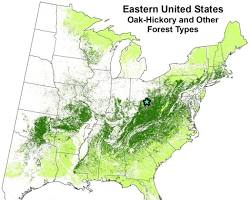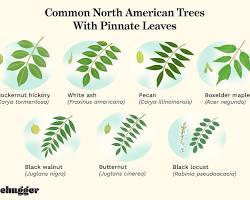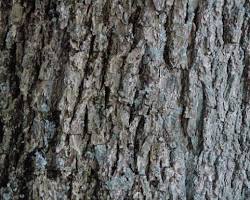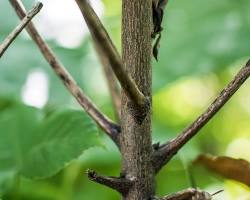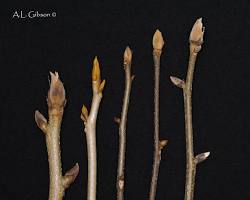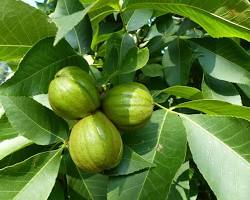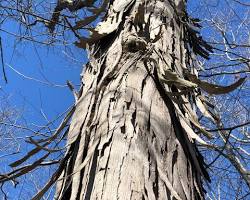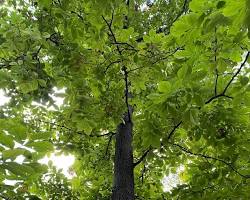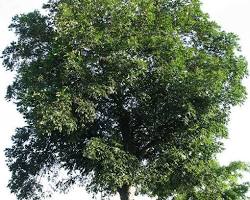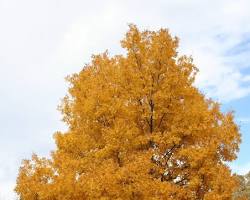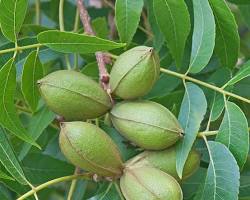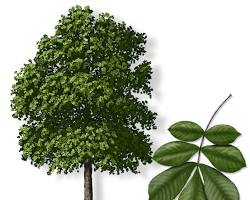Hickory trees are beautiful and majestic trees that are local to North America. They are recognised for his or her robust wood, fit to be eaten nuts, and colourful fall foliage. Hickory trees also are exceedingly clean to become aware of, with some key characteristics to search for.
In this blog post, we can provide a complete manual to hickory tree identification. We will cowl the whole lot you need to understand, from the leaves and bark to the twigs and buds. We may also speak how to identify one-of-a-kind hickory tree species.
What are hickory trees?
Hickory trees (genus Carya) are a group of deciduous trees native to North America. They are acknowledged for their tough, dense wooden, safe to eat nuts, and delightful fall foliage. Hickory trees can grow as much as a hundred feet tall and have a lifespan of over 300 years.
Where are hickory trees found?
Hickory trees are discovered in a number of habitats at some stage in North America, together with forests, woodlands, and riverbanks. They pick nicely-drained soils and complete solar to partial shade. Hickory trees are most common inside the japanese United States and elements of southern Canada.
Why are hickory trees important?
Hickory trees are vital for a number of motives:
- They provide food and shelter for natural world. Hickory nuts are a meals supply for plenty animals, together with squirrels, deer, birds, and foxes. Hickory trees additionally provide nesting and roosting web sites for birds and other animals.
- They improve soil high-quality. Hickory trees have deep roots that assist to break up the soil and enhance drainage. They additionally add organic count number to the soil as their leaves fall and decompose.
- They assist to save you erosion. Hickory trees have a dense cover that facilitates to protect the soil from erosion.
- They provide wooden for quite a few uses. Hickory wooden is powerful and durable, making it ideal for a whole lot of uses, along with furnishings, tools, floors, and sports equipment.
- They are lovely trees. Hickory trees have a special appearance, with their deeply furrowed bark and delightful fall foliage.
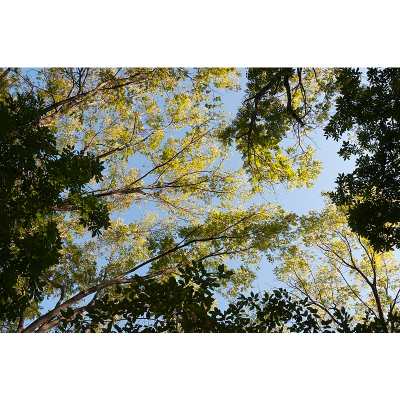
How to identify hickory trees
Hickory trees can be diagnosed by a number of characteristics, such as:
Leaves: Hickory leaves are pinnately compound, meaning that they have got a couple of leaflets organized alongside a principal stalk. The wide variety of leaflets on a hickory leaf varies depending on the species, but it’s miles generally between 5 and 9. Hickory leaflets are lance-formed to ovate, with sharply pointed hints and finely serrated or toothed margins. The leaves are dark inexperienced and smooth on pinnacle, and faded green or yellow-green on the lowest.
Bark: Hickory bark is gray, deeply furrowed, and regularly peeling. Some hickory species, including the shagbark hickory, have bark that peels again in long strips. Other hickory species, consisting of the pignut hickory, have bark this is clean and gray with slender ridges.
Twigs: Hickory twigs are tan and feature a pentagonal pith. The pith is the valuable column of tender tissue in a tree branch. Hickory trees are one of the few groups of trees which have a pentagonal pith.
Buds: Hickory buds are scaly, brown, and regularly pointed. They are organized alternately along the twig.
Nuts: Hickory nuts are hard-shelled and feature a thick husk. The nuts are oval or round in form and suitable for eating. Hickory nuts can be eaten raw, roasted, or utilized in baking.
If you’re unsure whether or not or now not a tree is a hickory, you may seek advice from a subject guide or ask a tree expert.
Here are a few extra pointers for figuring out hickory trees:
- Look for the pentagonal pith inside the twigs. This is a unique feature of hickory trees.
- Examine the bark. Hickory bark is usually gray and deeply furrowed, but it can range relying on the species.
- Pay attention to the leaves. Hickory leaves are pinnately compound and have a one-of-a-kind shape.
- Look for hickory nuts. Hickory nuts are tough-shelled and have a thick husk.
Hickory Tree Characteristics
Here are a number of the important thing characteristics of hickory trees:
- Leaves: Hickory leaves are pinnately compound, which means that they’ve more than one leaflets organized along a crucial stalk. The wide variety of leaflets on a hickory leaf varies depending at the species, but it’s far typically between 5 and 9. Hickory leaflets are lance-shaped to ovate, with sharply pointed pointers and finely serrated or toothed margins. The leaves are darkish green and glossy on pinnacle, and pale inexperienced or yellow-green on the bottom.Bark: Hickory bark is grey, deeply furrowed, and frequently peeling. Some hickory species, consisting of the shagbark hickory, have bark that peels lower back in long strips. Other hickory species, together with the pignut hickory, have bark that is smooth and gray with slim ridges.
- Twigs: Hickory twigs are tan and have a pentagonal pith. The pith is the relevant column of soft tissue in a tree department. Hickory trees are one of the few corporations of trees that have a pentagonal pith.
- Buds: Hickory buds are scaly, brown, and regularly pointed. They are organized alternately along the twig.
- Nuts: Hickory nuts are hard-shelled and feature a thick husk. The nuts are oval or spherical in form and fit for human consumption. Hickory nuts may be eaten raw, roasted, or utilized in baking.
Identifying Different Hickory Tree Species
There are over 18 species of hickory trees native to North America, every with its personal precise characteristics. While there are some widespread functions which are not unusual to all hickory trees, which include their pinnately compound leaves and pentagonal pith, there also are a few key differences that permit you to to perceive one of a kind species.
Here is a manual to figuring out some of the most common hickory tree species:
Shagbark Hickory (Carya ovata)
Bark: Shagbark hickory bark is grey and deeply furrowed, and it peels returned in long strips.
Leaves: Shagbark hickory leaves have 5-7 leaflets which might be lance-formed to ovate, with sharply pointed suggestions and finely serrated margins. The leaves are dark inexperienced and sleek on pinnacle, and faded green or yellow-green on the bottom.
Nuts: Shagbark hickory nuts are oval-fashioned and have a thick, four-ridged husk. The nuts are fit to be eaten and have a candy, nutty taste.
Pignut Hickory (Carya glabra)
Bark: Pignut hickory bark is grey and smooth, with narrow ridges.
Leaves: Pignut hickory leaves have 5-nine leaflets that are lance-formed to ovate, with sharply pointed pointers and finely serrated margins. The leaves are darkish green and sleek on top, and pale green or yellow-green on the bottom.
Nuts: Pignut hickory nuts are pear-fashioned and feature a thick, 4-ridged husk. The nuts are edible, but they have a sour flavor.
Shellbark Hickory (Carya laciniosa)
Bark: Shellbark hickory bark is gray and deeply furrowed, with large, plate-like scales.
Leaves: Shellbark hickory leaves have 7-nine leaflets which might be lance-shaped to ovate, with sharply pointed suggestions and finely serrated margins. The leaves are darkish green and sleek on top, and pale green or yellow-inexperienced on the lowest.
Nuts: Shellbark hickory nuts are massive and oval-formed with a thick, four-ridged husk. The nuts are fit for human consumption and have a candy, nutty taste.
Bitternut Hickory (Carya cordiformis)
Bark: Bitternut hickory bark is gray and smooth, with narrow ridges.
Leaves: Bitternut hickory leaves have five-7 leaflets which might be lance-shaped to ovate, with sharply pointed suggestions and finely serrated margins. The leaves are darkish inexperienced and smooth on pinnacle, and pale inexperienced or yellow-inexperienced on the lowest.
Nuts: Bitternut hickory nuts are round and have a skinny, four-ridged husk. The nuts are edible, however they have got a sour taste.
Pecan (Carya illinoinensis)
Bark: Pecan bark is gray and easy, with shallow ridges.
Leaves: Pecan leaves have eleven-17 leaflets which are lanceolate, with long, slender guidelines. The leaves are dark green and sleek on pinnacle, and pale green or yellow-inexperienced on the bottom.
Nuts: Pecan nuts are elongated and feature a thin, smooth husk. The nuts are safe to eat and have a sweet, nutty taste.
Mockernut Hickory (Carya tomentosa)
Bark: Mockernut hickory bark is grey and deeply furrowed, with broad, flat ridges.
Leaves: Mockernut hickory leaves have 7-nine leaflets which are lanceolate to ovate, with sharply pointed hints and finely serrated margins. The leaves are darkish inexperienced and bushy on top, and faded green or yellow-green and downy on the lowest.
Nuts: Mockernut hickory nuts are round to oval-fashioned and have a thick, 4-ridged husk. The nuts are edible, but they’ve a sour taste.
These are only some of the maximum commonplace hickory tree species. For greater statistics on identifying specific species, please seek advice from a subject guide or touch a local arborist.
Other Hickory Tree Species
In addition to the six commonplace hickory tree species noted above, there are a number of different hickory tree species native to North America. Here is a short review of some of these other species:
- Carolina Shagbark Hickory (Carya carolinae-septentrionalis): This species is just like the shagbark hickory, however it has smaller nuts and its bark peels back in shorter strips. It is determined in the southeastern United States.
- Sand Hickory (Carya pallida): This species has small, spherical nuts and clean, gray bark. It is located in sandy soils along the coast of the southeastern United States.
- Scrub Hickory (Carya floridana): This species is a small tree with easy, gray bark and round nuts. It is discovered in Florida and the southeastern coastal simple.
- Water Hickory (Carya aquatica): This species is found in swamps and bottomlands in the southeastern United States. It has big, round nuts and clean, grey bark.
- Nutmeg Hickory (Carya myristiciformis): This species has small, spherical nuts with a nutmeg-like taste. It is observed inside the southeastern United States.
- Kingnut Hickory (Carya laciniosa): This species is much like the shellbark hickory, but it has large nuts and bark that is deeply furrowed and plate-like. It is found within the Midwestern and northeastern United States.
- Texas Hickory (Carya texana): This species is found in Texas and Mexico. It has small, spherical nuts and smooth, gray bark.
- Mexican Hickory (Carya palmeri): This species is discovered in Mexico. It has small, spherical nuts and clean, gray bark.
- Chinese Hickory (Carya cathayensis): This species is local to China. It has huge, spherical nuts and smooth, gray bark.
- Vietnamese Hickory (Carya tonkinensis): This species is local to Vietnam. It has small, round nuts and smooth, gray bark.
These are only a few of the numerous other hickory tree species that can be discovered in North America and around the world. Hickory trees are a diverse organization of trees with a wide variety of traits. If you are inquisitive about getting to know greater approximately hickory trees, I encourage you to consult a discipline guide or touch a neighborhood arborist.
Hickory Tree Habitat and Range
Hickory trees are local to North America and are discovered in a number of habitats, together with forests, woodlands, and riverbanks. They pick well-tired soils and full solar to partial shade. Hickory trees are most common within the jap United States and parts of southern Canada.
Here is a map of the native variety of hickory trees in North America:
Hickory trees may be discovered in a variety of forest kinds, consisting of blended hardwood forests, o.K.Hickory forests, and very wellpine forests. They are also observed in woodlands, savannas, and riparian areas. Hickory trees are generally found in association with other hardwood trees, which includes okay, maples, and birches.
Hickory trees are tolerant of a wide range of soil sorts, however they decide on well-tired soils. They can grow in sandy soils, loamy soils, and clay soils. Hickory trees are also tolerant of a wide variety of pH tiers, but they decide on slightly acidic soils.
Hickory trees want full solar to partial color to grow well. They are not tolerant of deep color. Hickory trees are also reasonably drought-tolerant, however they select wet soils.
Hickory trees are an crucial a part of the North American atmosphere. They provide meals and shelter for a number of wildlife, including birds, squirrels, and deer. Hickory nuts also are a valuable food source for human beings.
Hickory Tree Uses
Hickory trees have a variety of makes use of, including:
- Wood: Hickory wooden is powerful and durable, making it ideal for quite a few makes use of, which includes fixtures, tools, flooring, and sports activities gadget. Hickory wooden is likewise used to make smoked meats and cheeses.
Buy Hickory Wooden table – Shop from Amazon
- Nuts: Hickory nuts are suitable for eating and can be eaten raw, roasted, or used in baking. Hickory nuts are an awesome source of protein and healthful fats.
- Wildlife habitat: Hickory trees provide food and refuge for a lot of wildlife, which includes birds, squirrels, and deer.
- Ornamentation: Hickory trees are stunning trees that may be planted for landscaping purposes. Their fall foliage is mainly stunning.
Here are a few particular examples of the way hickory wooden is used:
- Furniture: Hickory wooden is frequently used to make super furniture, together with tables, chairs, and shelves. Hickory fixtures is thought for its energy and sturdiness.
- Tools: Hickory wooden is likewise used to make tools, consisting of hammers, axes, and handles. Hickory equipment are recognised for their electricity and surprise resistance.
- Flooring: Hickory wooden is a popular choice for floors due to the fact it’s miles strong, durable, and has a stunning grain.
- Sports equipment: Hickory trees is used to make loads of sports device, such as baseball bats, lacrosse sticks, and golf club shafts. Hickory sports activities device is thought for its power and versatility.
- Smoked meats and cheeses: Hickory wood is used to smoke meats and cheeses as it imparts a completely unique flavor to the food.
Hickory nuts are also used in numerous approaches:
- Food: Hickory nuts may be eaten raw, roasted, or used in baking. Hickory nuts have a rich, nutty taste and are a good supply of protein and healthy fat.
- Oil: Hickory nut oil may be made from hickory nuts and is utilized in cooking and salad dressings. Hickory nut oil has a high smoke factor and a nutty taste.
- Crafts: Hickory nuts may be used to make a whole lot of crafts, which includes jewelry and ornaments.
Hickory Tree Pests and Diseases
Hickory trees are susceptible to some of pests and sicknesses, consisting of:
Pests
- Hickory bark beetle: This beetle bores into the bark of hickory trees and might kill them.
- Hickory scale: This scale insect sucks sap from hickory trees and can weaken them.
- Hickory leaf curler: This caterpillar rolls up hickory leaves and feeds on them.
- Hickory aphid: This aphid sucks sap from hickory trees and may weaken them.
- Hickory nut casebearer: This caterpillar feeds on hickory nuts and might harm them.
Diseases
- Anthracnose: This fungus reasons leaf spots and may defoliate hickory trees.
- Canker: This fungus causes cankers on the bark of hickory trees and may kill them.
- Witches’-broom: This fungus causes witches’-brooms, which might be dense clusters of twigs, on hickory trees.
- Leaf rust: This fungus causes rust spots on hickory leaves.
- Powdery mould: This fungus reasons a white powdery coating on hickory leaves.
Prevention and Control
There are a number of things that may be finished to prevent and control hickory pests and sicknesses:
- Inspect hickory trees regularly for signs of pests and diseases.
- Remove any useless or diseased branches from hickory trees.
- Water hickory trees often at some point of dry climate.
- Fertilize hickory trees in the spring and fall.
- Apply insecticidal cleaning soap or neem oil to hickory trees to govern pests.
- Apply fungicide to hickory trees to manipulate sicknesses.
If you have got a hickory tree this is infested with pests or diseases, it is important to visit an authorized arborist to decide the satisfactory route of action.
Conclusion
Hickory trees are valuable assets that have quite a few uses. They are vital for natural world, provide meals and shelter for humans, and are used to make a whole lot of products.
Hickory trees also are lovely trees that could upload a touch of beauty to any belongings. If you’re considering planting a hickory tree, be sure to choose a properly-tired region and offer the tree with normal watering and fertilization.
Also Read : Difference between Celebration Maple and Autumn Blaze

